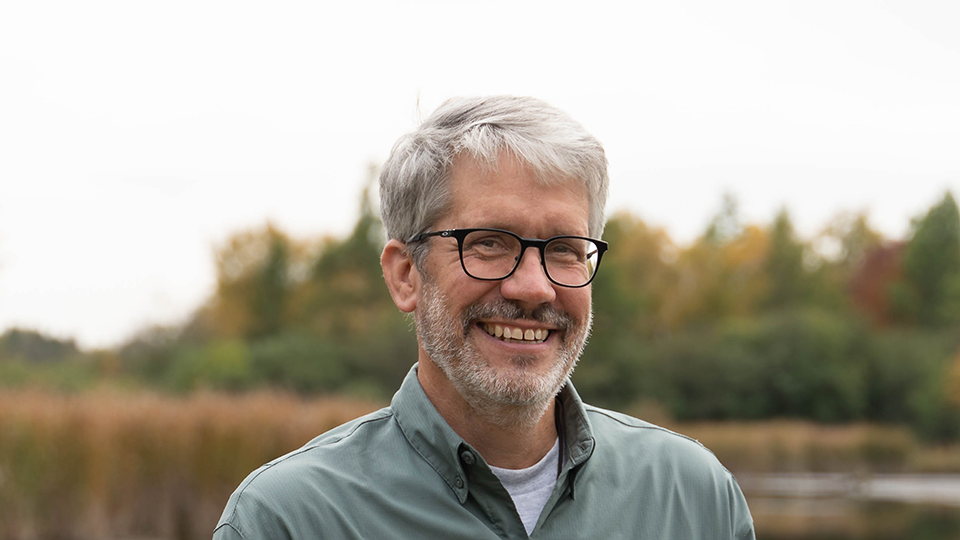
Dr. Mark Edlund, Senior Scientist
Ph.D., University of Michigan (Natural Resources and Environment), 1998
M.S., University of Michigan (Natural Resources), 1992
B.S., University of Minnesota (Biochemistry/Botany), 1987
Phone: (651) 433-5953 ext. 26
email: medlund@smm.org
Academic Appointments
Adjunct Faculty Appointments
Biology Faculty, National University of Mongolia
Water Resources Science, University of Minnesota
Assistant Professor (Visiting)
Iowa Lakeside Laboratory, Iowa State University, Ecology and Systematics of Diatoms
Research Interests
My research interests have developed around aquatic biology and algae, especially the diatoms. Diatoms are microscopic algae characterized by their ornate cell walls made of opaline silica, or biologically produced glass. I use diatoms to pursue these research and teaching areas:
Historical environmental change-paleolimnology
Because diatoms are made of glass, they accumulate in the bottom of lakes, providing researchers clues to conditions in a lake system in earlier times. We use diatom subfossils to measure change in historical diatom communities, lake productivity, and nutrient levels in response to climate, landuse changes, and management practices. Current projects include:
Resurrection Ecology – This NSF-funded project examines how organisms adapt to environmental change. The zooplankton Daphnia produces a resting structures called ephippia that have been shown to survive for decades to centuries in lake sediments. Sediment cores are being collected from two Minnesota lakes with contrasting environmental histories—Hill Lake in Aitkin Co. and South Center Lake in Chisago Co.—and biogeochemical records in the cores are being studied to reconstruct historical environmental changes. Ephippia are being isolated and hatched to test how Daphnia have responded physiologically and genetically to environmental drivers.
Wisconsin Lakes – Polk County, Wisconsin, boasts over 400 lakes that are prized for their beauty and recreational opportunities. However, many of the lakes suffer from impaired water quality, algal blooms, and non-native species. We are using sediment cores to determine pre-disturbance condition, develop a timeline of historical impairment, and set attainable management goals for several lakes (Polk County Land and Water
Metro Lakes – The Twin Cities metro area has an abundance of lakes that are focal points for recreation, development, and water management. Working in collaboration with various watershed districts and counties, we examine sediment cores from lakes to determine the history and extent of ecological change. These data are used to direct mitigation efforts, develop nutrient management plans (TMDL), and examine the effect of management strategies. Current lakes that we're working on include Dean Lake (Scott Co) and Rice Marsh Lake (Chanhassen); recently completed projects include Spring Lake and Arctic Lake (Prior Lake).
Biomonitoring and biodiversity of aquatic resources
Our current biomonitoring research is directed at lakes and aquatic resources in the National Parks of the Upper Midwest. We recently finished a project is exploring the ecology of splash pools at three Lake Superior parks – a seasonal inventory of water quality and biology (diatoms, zooplankton, insects, amphibians) – to determine vulnerability of shoreline resources. Another project has developed a novel technique to use repeat sampling of sediments from NPS lakes to determine extent and trajectory of ecological change.
Diatoms of the United States – Edlund serves on the Editorial Board for the web-based resource, "Diatoms of the United States," a singular source of taxonomic information on diatom diversity in the US .
Ecological change in large lakes
Laurentian Great Lakes – The Great Lakes are undergoing unprecedented change in response to introduced species and climate change. We are working to understand dramatic food web shifts in Lake Michigan, including the disappearance of the benthic invertebrate Diporeia, using a two pronged approach that investigates food resource shifts preserved in sediment cores coupled with gut content analysis of historical Diporeia collections. Other Great Lakes work investigates the recently modified pathway by which botulism outbreaks have returned to the shores of Lake Michigan.
Lake of the Woods – Situated on the border of Minnesota and Canada, Lake of the Woods is experiencing greater frequency and extent of blue-green algae blooms despite documented reductions in phosphorus loading since the 1970s. We are using analysis of multiple sediment cores from throughout the southern basin to reconstruct a historical phosphorus budget for the lake in collaboration with researchers with the MPCA, University of Minnesota-Duluth, and Ontario Ministry of the Environment.
Biodiversity and ecological change in ancient lakes and landscapes
We've been working in Mongolia since 1996 and recently completed a survey of the diatom flora of western Mongolia's Valley of the Great Lakes. This landscape is dominated by two large saline lakes (Uvs and Khyargus Nuur) and many smaller lakes that range from fresh to hypersaline. Results that show recent eutrophication of lakes from interactions of grazing and climate drivers are fueling our next proposal. Other ancient lakes that we've worked on include Eocene kimberlite deposits in Canada, Mongolia's Lake Hövsgöl, Russia's Lake Baikal, Macedonia's Lake Ohrid, and Quebec's Pingualuit Crater Lake.
Life history strategies
Conservative estimates set the number of living diatom species at about 25,000, but knowledge of sexuality and life histories is known for only approximately 300 species. This shortfall provides a modern challenge to further a rich scientific history on algal sexuality. My work in this field has centered on description and cytology of sexuality and dormancy strategies. Our new publication presents a standardized terminology for the structures and stages present during the sexual and resting stages of the diatom life history (Kaczmarska et al. 2013)
TEACHING: Ecology and Systematics of Diatoms
Since 1963, the summer field course, "Ecology and Systematics of Diatoms," has been taught at Iowa Lakeside Laboratory near Spirit Lake, Iowa. I've been teaching this class since 2003 with Dr. Sarah Spaulding (UColo) and Dr. Marina Potapova (ANSP). Each year ten students plus visiting researchers from across the US and around the world gather for the only four-week course taught in North America focused specifically on diatoms. Learn more
Publications
See a full list of Dr. Mark Edlund's publications here.